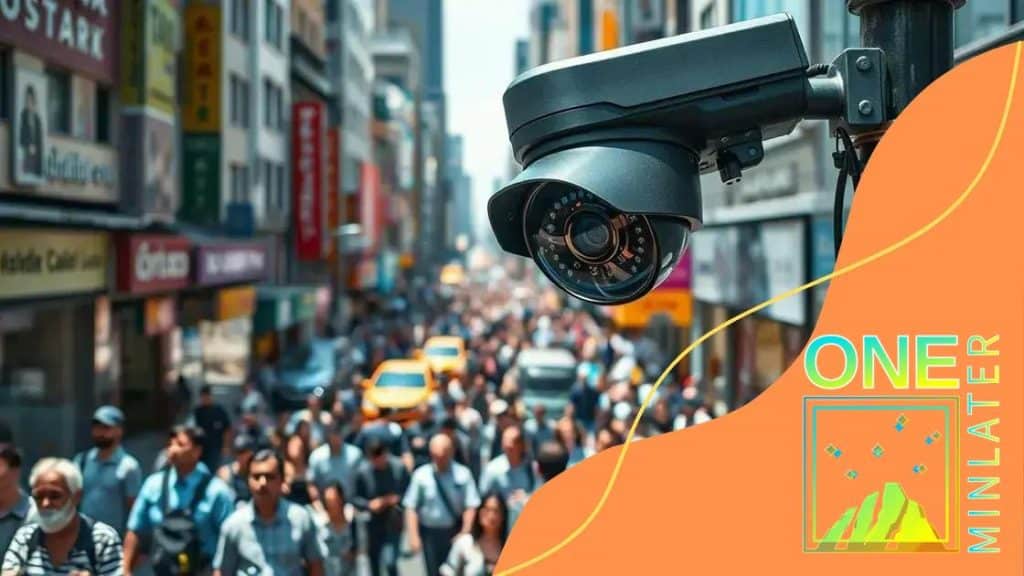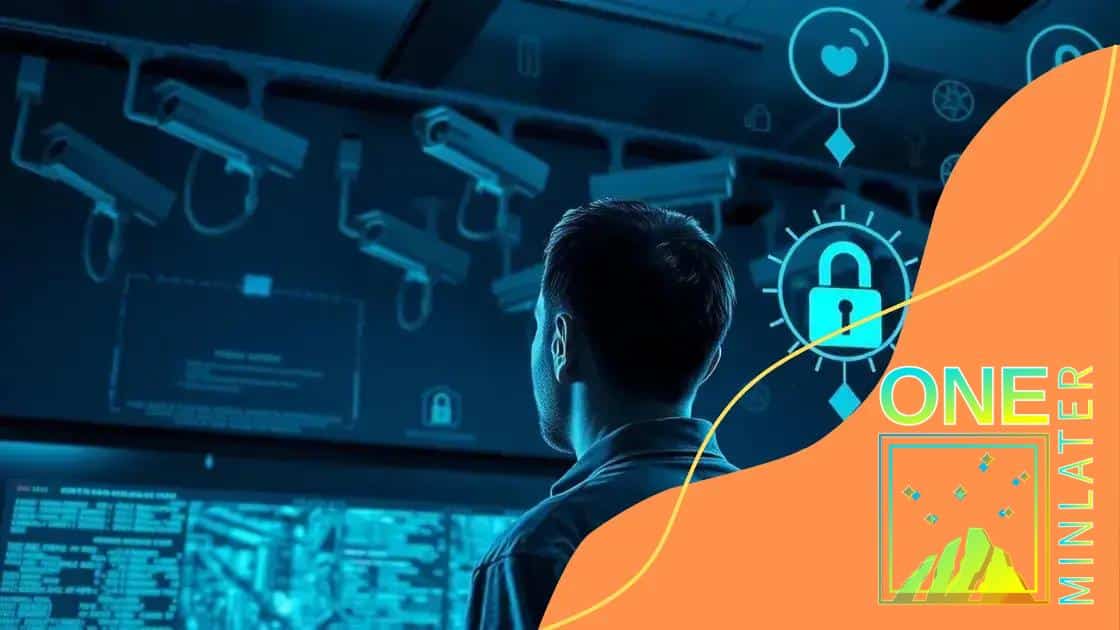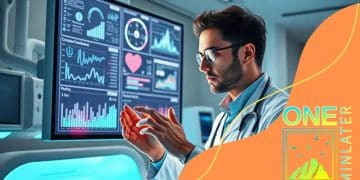The role of facial recognition in enhancing public safety

The role of facial recognition in enhancing public safety involves its use in identifying suspects, improving security at events, and addressing privacy concerns while advancing technology and ethical considerations.
The role of facial recognition in enhancing public safety is more significant than ever, stirring conversations about security and privacy. Have you considered how this technology influences your daily life? Let’s dive deeper into its effects.
Understanding facial recognition technology
Understanding facial recognition technology is crucial in today’s digital age. This technology analyzes facial features to identify individuals from images or video feeds. As we explore its applications, it’s important to grasp how it works.
How Facial Recognition Works
The process begins with capturing an image. The software detects faces and then measures unique features, such as the distance between eyes or the shape of the jaw. These measurements create a digital representation of the face, often called a faceprint.
Key Applications
- Security systems: Facial recognition enhances security by verifying identities in sensitive areas.
- Law enforcement: Police use this technology to identify suspects in investigations.
- Access control: Many companies implement this for secure building entry.
Another significant aspect is its role in social media. Platforms utilize facial recognition to automatically tag users in photos, making sharing more interactive. This technology also assists in customer experiences, such as personalized advertising based on recognized identities.
Despite its many benefits, facial recognition technology raises important questions about privacy. As its use expands, discussions about ethical implications grow. Balancing safety and privacy is critical as society moves forward with this technology.
Applications in law enforcement
Applications in law enforcement play a pivotal role in how authorities maintain public safety. This technology helps in identifying suspects and gathering evidence for investigations.
Identification of Suspects
Facial recognition systems allow law enforcement to match faces captured in surveillance footage with criminal databases. Such tools expedite the identification process, often leading to faster arrests. By using these tools, officers can verify identities during traffic stops or in public spaces.
Evidence Collection
In addition to identifying suspects, facial recognition is crucial for collecting evidence. Videos and photos from crime scenes can be analyzed to locate individuals involved. This capability improves the effectiveness of investigations by providing reliable leads.
- Real-time monitoring: Some police departments utilize live monitoring systems to track suspects in crowded areas.
- Missing persons: This technology aids in locating missing individuals by cross-referencing faces from images reported by the public.
- Crime prevention: Enhanced surveillance capabilities can deter crime in public areas by making potential offenders aware of the technology in use.
However, the adoption of facial recognition in law enforcement raises ethical concerns. Issues related to privacy and the potential for misuse are ongoing debates. Balancing effective policing with individual rights is essential for society as these technologies evolve.
Privacy concerns and ethical considerations

Privacy concerns and ethical considerations are at the forefront of discussions surrounding facial recognition technology. As this technology becomes more prevalent, questions arise about how it affects our daily lives.
Impact on Personal Privacy
One major concern is the invasion of personal privacy. With cameras widely placed in public spaces, facial recognition can track individuals without their consent. This type of surveillance prompts many to wonder if it infringes on their rights.
Potential for Misuse
Another critical issue is the potential misuse of facial recognition technology. Authorities may deploy it for purposes beyond law enforcement, such as monitoring political protests or gathering information about citizens. Such actions can lead to a chilling effect on free speech and public assembly.
- Data security: Protecting the data collected is crucial, as breaches can expose sensitive information.
- Discrimination risks: Studies show that facial recognition may not perform equally across different demographics, leading to potential bias in identifications.
- Lack of regulation: Many countries lack comprehensive laws governing the use of this technology, allowing for unchecked implementation.
Engaging the public in discussions about these concerns is vital. Citizens must be informed about how their data is being used and have a say in regulations. Addressing ethical considerations will help shape policies that prioritize both innovation and individual rights.
Impact on public events and safety
Impact on public events and safety is increasingly significant as facial recognition technology becomes integrated into security measures. This innovation has a profound influence on how we experience large gatherings.
Enhanced Security Measures
At public events, such as concerts and sporting events, facial recognition systems allow for real-time monitoring of attendees. Security personnel can identify known threats before they escalate, improving safety outcomes. These tools often work in conjunction with other security systems to create a comprehensive approach.
Deterrence of Criminal Activity
Facial recognition technology also serves as a deterrent to potential wrongdoers. When individuals are aware that their faces may be recorded and analyzed, they may think twice before engaging in illegal activities. This heightened sense of surveillance can lead to safer environments.
- Access control: Some events use facial recognition for entry, speeding up the process and minimizing fraud.
- Monitoring crowd behavior: Authorities can track how crowds move and respond to certain situations, enabling better management of large gatherings.
- Rapid response: In emergencies, quick identification of individuals can significantly aid first responders.
Nevertheless, this technology raises questions about civil liberties. While it enhances safety, it also leads to discussions about privacy. Striking a balance between security and individual rights is vital, especially in environments where large groups gather.
Future trends in facial recognition systems
Future trends in facial recognition systems suggest significant advancements that will shape how we interact with technology. As AI evolves, these systems become more accurate and integrated into everyday life.
Improved Accuracy and Speed
One key trend is the development of algorithms that enhance accuracy. Advances in machine learning enable facial recognition systems to reduce error rates. This improvement means systems can correctly identify faces in diverse conditions, such as low light or crowded environments.
Integration with Other Technologies
Facial recognition will increasingly work alongside other technologies, such as AI surveillance systems and smartphone security. This integration allows for seamless experiences, like faster identification at security checkpoints. Users can expect more personalized interactions, as devices recognize them and adapt settings accordingly.
- Smart cities: Urban areas may implement facial recognition to improve public safety and streamline city services.
- Healthcare applications: Hospitals might use this technology for patient identification, enhancing security and efficiency.
- Remote identification: As remote work becomes standard, facial recognition could help verify users in online transactions.
Despite these advancements, ethical concerns remain. As the technology spreads, discussions about privacy rights will become more pressing. Balancing innovation with responsible use will be essential for the future of facial recognition systems. Striking this balance could define how society embraces these new capabilities.
FAQ – Frequently Asked Questions about Facial Recognition Technology
What is facial recognition technology?
Facial recognition technology is a system that identifies or verifies a person by analyzing their facial features from images or videos.
How is facial recognition used in law enforcement?
Law enforcement uses facial recognition to identify suspects, gather evidence, and enhance security during public events.
What are the privacy concerns associated with facial recognition?
Privacy concerns include unauthorized surveillance and the potential misuse of data, raising questions about personal rights.
What are future trends in facial recognition technology?
Future trends include improved accuracy, integration with smart devices, and advancements in algorithms for real-time identification.





